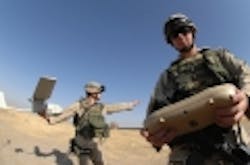Flight training and simulation designers are pressed for ever-more features and graphics
ARLINGTON, Texas, 19 Oct. 2010. Aerospace and defense systems integrators and end users want more from their flight training and simulation systems -- more content, more capabilities, and more resolution -- and they want it for less money and in a smaller size.
Certainly, customers in the mil-aero community are not unique in this regard. Technology firms, such as L-3 Link, are working toward adding all of the richness of high-definition content, enhanced capabilities, and a wide array of complex training scenarios in flight simulators, says Frank Delisle, vice president of engineering and technology at L-3 Link Simulation & Training in Arlington, Texas.
Systems also need to “handle higher-fidelity sensors, including high-resolution infrared, electro-optical systems, night-vision goggles, and high-resolution radars,” he says. “All have to be connected and play together to create an immersive training environment. In short, the big focus of the solutions and the technology is to take as much of the training of the real aircraft in the training simulation systems.
“Our customers have been stepping up the tempo of trying to get more and more capabilities in the solution,” Delisle says. “We have been continuing to implement high-definition, high-fidelity technology in the trainers that can support the military’s training and readiness objectives.” In fact, a new F-16 Mission Training Center (MTC) contract stemmed from the U.S. government officials’ desire to acquire the latest and greatest; the requirements were for the highest definition and greatest capabilities that were available.
L-3 Link won a $21 million contract option from the Air Force Aeronautical Systems Center's Training Systems Product Group at Wright Patterson Air Force Base, Ohio, to build a third F-16 MTC suite. According to the contract option, which brings the total contract value on the program to $132.8 million, L-3 Link engineers will build and deliver an F-16 MTC suite that includes four high-definition simulators.
Each of the F-16 MTC suites is being integrated with L-3 Link's HD World simulation product line, which combines high-definition databases, image generation systems, physics-based processing technology, and visual system displays to create highly realistic and relevant environments for F-16 pilot training.
SimuSphere HD, the visual display component to HD World, provides users an immersive, high-definition, 360-degree field-of-view. High-definition technology provides pilots the visual acuity to detect, orient, and recognize targets as they do in the real world, Delisle explains. “We have to feed these displays with richer and richer content: what you would see in urban or rich terrain environments; all the details and all the fidelity of the buildings and vehicles; and crowd behaviors. You need all that rich content, together with enabling technology; it is really where the solutions are focused today. Previous technologies (displays and CG systems) didn’t have the processing capacity or the resolution to be able to do real-world detection and orientation of targets and be able to create that kind of fidelity.”
"For the first time ever in a simulator, F-16 pilots will be able to detect, judge the orientation of, recognize, and identify targets from the same distance as when flying an actual mission," Bob Birmingham, president of L-3 Link, describes. "This advanced simulation capability will maximize pilot operational readiness, while reducing training costs for the U.S. Air Force."
Under the program, the U.S. Air Force could order as many as 20 F-16 MTCs for installations in the U.S., Europe, and Pacific region. High-fidelity F-16 MTC simulators will model the fighter aircraft's weapon systems and ordnance, and will support basic and advanced pilot mission training, tactics validation, and mission rehearsal.
“It’s a beyond-the-state-of-the-art flight simulation trainer in many ways,” Delisle notes. “The F-16 MTC sets a new standard for high fidelity.” The premier flight training system delivers high-definition, high-resolution, high-fidelity training capability, he says. The company’s HD World technology is also being used to upgrade F-18 trainers with high-definition imagery.
